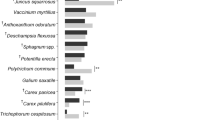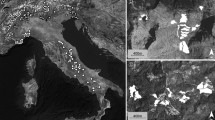Abstract
Conservation of once thought extinct populations of Lycaena xanthoides in western Oregon will require specific information of how the butterfly interacts with its now rare wetland habitat. Three experiments were conducted to yield information directly applicable to wetland restoration work: (1) to quantify the survival of L. xanthoides eggs laid on inundated plants, (2) to quantify adult nectar preferences, (3) to investigate the role of adult resources and how butterflies assess habitat quality. Survival of eggs laid on inundated plants was nearly seven times lower than the survival of eggs laid on uninundated plants, indicating that eggs laid on plants that are seasonally flooded are a population sink. Adult L. xanthoides preferred an endemic native nectar plant, Grindelia integrifolia × nana, as an adult resource and used it approximately 88% of the time while other butterfly species preferred to nectar on the non-native Mentha pulegium. Adult L. xanthoides had a significantly greater short-term recapture rate in two restored study sites that had a high relative amount of Grindelia integrifolia × nana compared to a degraded site that lacked the preferred nectar source. Based on the results from the three small experiments, restoration of wetlands for L. xanthoides should concentrate plantings of host plant in non-flooded areas and propagate conspicuous patches of the preferred nectar plant.
Similar content being viewed by others
References
Alverson E (2005) Preserving prairies and savannas in a sea of forest: a conservation challenge in the Pacific Northwest. Plant Talk 40:23–27
Auckland JN, Debinski DM, Clark WR (2004) Survival, movement, and resource use of the butterfly Parnassius clodius. Ecol Entomol 29:139–149
Boyd R (1986) Strategies of Indian burning in the Willamette Valley. Can J Anthro 5:65–85
Dornfeld EJ (1980) The butterflies of Oregon. Timber Press, Corvallis, Oregon
Duffey E (1968) Ecological studies on the large copper butterfly, Lycaena dispar batavus, on Woodwalton Fen National Nature Reserve. J Appl Ecol 5:69–96
Duffey E (1977) The reestablishment of the large copper butterfly, Lycaena dispar batavus, on Woodwalton Fen National Nature Reserve. Biol Conserv 12:143–158
Emmel TC, Emmel JF (1973) The butterflies of Southern California. Natural History Museum of Los Angeles County, California
Emmel JF, Pratt GF (1998) New subspecies of Lycaeninae from California and a type locality restriction for Chrysophanus cupreus W. H. Edwards (Lepidoptera: Lycaenidae). In: Emmel TC (ed) Systematics of western North American butterflies. Mariposa Press, Gainsville Florida, pp 661–680
Finley KF (1995) Hydrology and related soil features of three Willamette Valley wetland prairies. M.S. Thesis. Oregon State University, Corvallis, pp 94
Holt EA, Severns PM (2005) The effects of prescribed burning on wet prairie lichen communities. Nat Areas J 25:130–136
Joy J, Pullin AS (1997) The effects of flooding on the survival and behaviour of overwintering large heath butterfly Coenonympha tullia larvae. Biol Conserv 82:61–66
Joy J, Pullin AS (1999) Field studies on flooding and survival of overwintering large heath butterfly Coenonympha tullia larvae on Fenn’s and Whixall mosses in Shropshire and Wrexham, UK. Ecol Entomol 24:426–431
Konvička M, Nedved O, Fric Z (2002) Early-spring floods decrease the survival of hibernating larvae of a wetland-inhabiting population of Neptis rivularis (Lepidoptera: Nymphalidae). Acta Zoo Acad Hung 48:79–88
Layberry RA, Hall WP and Lafontaine JD (1998) Butterflies of Canada. University of Toronto Press
Lederhouse RC (1982) Factors affecting equal catchability in two swallowtail butterflies, Papilio polyxenes and P. glaucus. Ecol Entomol 7:379–383
Maben S 2004. Wetlands harbor rare butterfly. The Register Guard, Eugene, Oregon, 17-July-2004, pp A1, A11
Mallet J, Longino JT, Murawaski D, Murawaski A, Simpson de Gamboa A (1987) Handling effects in Heliconius: where do all the butterflies go? J Anim Ecol 56:377–386
Morton AC (1982) The effects of marking and capture on recapture frequencies of butterflies. Oecologia 53:105–110
New TR (1997) Are Lepidoptera an effective “umbrella group” for biodiversity conservation? J Insect Conserv 1:5–12
Nichols CN and Pullin AS (2003) The effects of flooding on survivorship in overwintering larvae of the large copper butterfly Lycaena dispar batavus (Lepidoptera: Lycaenidae), and its possible implications for restoration management. Eur J Entomol 100:65–72
Orsak LJ (1977) The butterflies of Orange County, California. University of California Press, New York
Pendergrass KL, Miller PM and Kauffman JB (1998) Prescribed fire and the response of woody species in Willamette Valley wetland prairies. Restor Ecol 6:303–311
Pullin AS, Balint Z, Balleto E, Buszko J, Coutsis JG, Goffart P, Kulfan M, Lhonore JE, Settle J, Van der Made JG (1998) The status, ecology and conservation of Lycaena dispar (Lycaenidae: Lycaenini) in Europe. Nota Lepid 21:94–100
Pyle RM (2002) The butterflies of Cascadia. Seattle Audubon Society, Seattle, Washington
Ramsey FL, Schafer DW (2002) The statistical sleuth: a course in methods of data analysis, 2nd edn. Duxbury. Pacific Grove, CA, pp 742
Schneider C, Dover J, Fry GLA (2003) Movement of two grassland butterflies in the same habitat network: the role of adult resources and size of the study area. Ecol Entomol 28:219–227
Scott JA (1975) Flight patterns among eleven species of diurnal Lepidoptera. Ecology 56:1367–1377
Scott JA and Opler PA (1975) Population biology and adult behavior of Lycaena xanthoides (Lycaenidae). J Lepid Soc 29:63–66
Sei M (2004) Larval adaptation of the endangered maritime ringlet Coenonympha tullia nipisiquit McDonnough (Lepidoptera: Nymphalidae) to a saline wetland habitat. Envir Entomol 33:1535–1540
Severns PM (2003) The effects of a fall prescribed burn on Hemileuca eglanterina Boisduval (Saturniidae). J Lepid Soc 57:137–143
Severns PM, Villegas S (2005) Butterflies hanging on to existence in the Willamette Valley: a relict population of the great copper (Lycaena xanthoides Boisduval). Northwest Sci 79:77–80
Shapiro AM (1974) The butterfly fauna of the Sacramento Valley, California. J Res Lepid 13:73–82, 115–122, 137–148
Shapiro AM (2002) The California urban butterfly fauna is dependent on alien plants. Divers Distr 8:31–40
Singer MC and Wedlake P (1981) Capture does affect probability of recapture in a butterfly species. Ecol Entomol 6:215–216
Warren AD (2005) Lepidoptera of North America 6. Butterflies of Oregon their taxonomy, distribution, and biology. Contributions of the C.P. Gillette Museum of Arthropod Diversity, Colorado State University, Fort Collins, pp 408
Webb MW, Pullin AS (1998) Effects of submergence by winter floods on diapausing caterpillars of a wetland butterfly, Lycaena dispar batavus. Ecol Entomol 23:96–99
Webb MW, Pullin AS (2000) Egg distribution in the large copper butterfly Lycaena dispar batavus (Lepidoptera: Lycaenidae): host plant versus habitat mediated effects. Eur J␣Entomol 97:363–367
Wiklund C (1977) Oviposition, feeding and spatial separation of breeding and foraging habitats in a population of Leptidea sinapis (Lepidoptera). Oikos 28:56–68
Wilson MV, Erhart T, Hammond PC, Kaye TN, Kuykendall K, Liston A, Robinson AF Jr, Schultz CB, Severns PM (2003) Biology of Kincaid’s lupine (Lupinus sulphureus ssp. kincaidii [Smith] Phillips), a threatened species of western Oregon native prairies. Nat Areas J 23:72–83
Wright DM (1983) Life history and morphology of the immature stages of the bog copper butterfly Lycaena epixanthe (Bsd.␣& Le C.) (Lepidoptera: Lycaenidae). J Res Lepid 22:47–100
Acknowledgements
We thank Evrim Karacetin for helping collect data on adult butterfly nectaring at the sites, Nate Miller and Emma Bradford for their aid in measuring vegetation, and B. Newhouse, E. Karacetin, and two anonymous reviewers for providing helpful comments on the manuscript.
Author information
Authors and Affiliations
Corresponding author
Rights and permissions
About this article
Cite this article
Severns, P.M., Boldt, L. & Villegas, S. Conserving a wetland butterfly: quantifying early lifestage survival through seasonal flooding, adult nectar, and habitat preference. J Insect Conserv 10, 361–370 (2006). https://doi.org/10.1007/s10841-006-9011-3
Received:
Accepted:
Published:
Issue Date:
DOI: https://doi.org/10.1007/s10841-006-9011-3




